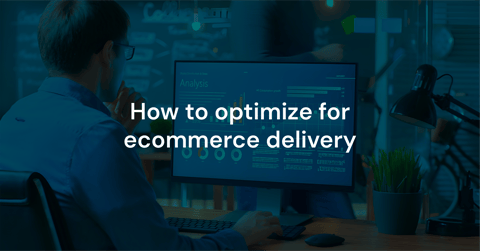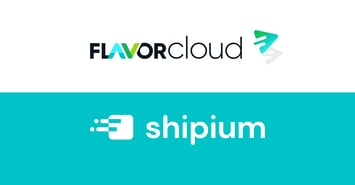Manhattan WMS: How to Optimize for Ecommerce Delivery

Shipping is one of the most significant operating expenses for ecommerce businesses, and many find it challenging to control these costs while improving their overall shipping operations to meet increasingly aggressive consumer demands for delivery speed.
Manhattan Active® Warehouse Management, along with prior Manhattan WMS versions still positively serving customers today, helps ensure your warehouse fulfillment operates efficiently within your broader supply chain ecosystem. But is your system properly optimized to address modern ecommerce delivery challenges?
Let's explore seven ways to optimize Manhattan WMS for delivery efficiency, reducing costs and boosting customer experience.
1. Adopt multiple carriers
Offering cost-effective shipping options has become a standard expectation. But it isn’t realistic if you rely on only one or two carriers alone. Applying a multi-carrier strategy provides the flexibility and optimization needed to live up to delivery promises.
Diversifying your carrier mix offers:
- Cost reduction: Using multiple carriers, you can compare rates for each shipment to choose the most cost-effective option.
- Delivery performance: Leveraging a diverse carrier network, you can optimize routing by selecting shipping options based on factors like destination, delivery speed, package characteristics, and carrier data.
- Scalability: Adopting a multi-carrier strategy provides flexibility for growth, streamlines operations, and allows businesses to adapt efficiently to changing shipping demands.
Combining the Shipium platform with Manhattan WMS helps streamline the carrier management process. Our extensive pre-integrated carrier network reduces rollout times, allowing you to add new carriers within a day. For carriers not currently part of the Shipium network, we can integrate them into your mix in eight weeks.
2. Add regional carriers
Integrating regional carriers into your strategy can provide a shortcut to savings and increased performance. They are already optimized for their specific geographies and benefit from lower overhead than their national counterparts, making them particularly cost-effective.
With regional carriers in your mix, you can leverage:
- Local expertise for faster delivery: Regional carriers' deep understanding of local geography and traffic patterns enables more efficient routing and quicker adaptability, resulting in faster delivery times, including next-day or same-day options in their service areas.
- Enhanced flexibility and reliability: Local carriers often provide more flexible options, such as later pick-up and after-hours delivery times. You also reduce the risk of disruptions and ensure more reliable deliveries, especially during peak seasons.
3. Integrate flexible technology
The ability to quickly adapt your shipping strategy can make or break your customer experience. Legacy systems often require weeks or months to implement changes, leaving you unable to respond to sudden market shifts or business needs.
Focus on implementing flexible technology that allows for:
- Rapid adjustments: Modify your shipping rules and priorities based on business developments in real time. Examples could include adjusting EDDs to accommodate a limited-time promotion or managing expectations accordingly in the case of production delays affecting stock levels.
- Enhanced operational agility: Empower your operations team to make data-driven decisions, such as adding a 3PL service to your carrier mix to reduce transit times in a particular region – without waiting for lengthy IT processes.
- Increased cost optimization: Adjust your shipping strategy to balance cost and service levels as needed. For example, you could shift from prioritizing the cheapest option to ensuring delivery by a specific date to meet increased peak season demand without system overhauls.
Look for platforms that take an API-first approach. These developer-friendly tools can simplify Manhattan integration, add flexibility, and reduce implementation timelines.
4. Provide transparent delivery promises
Estimated delivery dates (EDD) help increase cart conversions for ecommerce brands. But static delivery guarantees to boost sales can result in missed delivery dates, leading to unhappy customers and increased costs as you attempt to meet unrealistic promises by using premium shipping services.
To make delivery promises that you can keep, you need to implement EDDs powered by transit data from your systems (ecommerce platform, OMS, WMS and TMS).
With accurate, data-driven delivery promises, you:
- Boost sales and customer loyalty: Reliable delivery dates build trust and improve the shopping experience. For example, Shipium delivery promises can increase average conversions by around 4%.
- Streamline operations and cut costs: Accurate promises aren't just customer-facing. A better understanding of your transit times allows you to manage inventory better, choose optimal shipping methods, and reduce rush shipping and return costs.
Shipium’s dynamic time-in-transit models, powered by machine learning and an expert data science team, help augment your existing Manhattan systems to help solve for the variable and volatile parts of transportation. You can rely on your industry-leading inventory and order management solutions with Manhattan to know accurate availability, then pair it with our transit calculations to get the most accurate EDDs in the industry.
5. Streamline cartonization
Ensuring effective cartonization, which determines optimal packaging configuration, can improve operational efficiency, reduce costs, and enhance customer satisfaction. Using robust cartonization capabilities built into Manhattan WMS, you can optimize your packaging process, leading to the following:
- Lower shipping costs: Minimized excess space in packages helps you avoid dimensional weight charges and allows for cheaper shipping rates.
- Improved space utilization: Efficient packaging maximizes warehouse space and delivery vehicle capacity.
- Enhanced product protection: Well-fitted packaging reduces the risk of damage during transit.
Manhattan provides excellent cartonization solutions within its WMS. Sometimes, customers want to pull that upstream into other areas of their operations. In that case, a shipping partner like Shipium can help through microservices related to cartonization.
Discover how to optimize cartonization and lower shipping costs with Shipium’s packaging planner API.
6. Unify shipping operations
Unified operations across systems and fulfillment points are key to optimizing your ecommerce delivery. By integrating Manhattan's warehouse and order management solutions with a platform like Shipium, you can keep your existing systems connected, driving efficiency and uncovering opportunities.
Benefits of unifying your operations include:
- Real-time data exchange that provides a bigger picture, allowing you to effectively identify bottlenecks, whether in picking, packing, or last-mile delivery.
- Improved inventory placement optimizes your time in transit by ensuring you ship products from the right warehouse for every order.
- Consistent customer experience ensures your promises and policies are consistent across all channels and touchpoints.
7. Optimize continuously
You need to monitor your performance and optimize your processes to maintain high on-time delivery accuracy at the lowest per-package pricing. Combining the insight provided by the native monitoring in your Manhattan warehouse management system with the advanced capabilities of tools like Shipium Simulation allows you to make informed decisions about your shipping strategies.
The Simulation offering allows you to tweak different customizations to get an understanding of how changes can impact your business so you can:
- Predict and analyze the results of updates, such as adding new carriers, before implementing them in your shipping network.
- Identify significant cost-saving opportunities by simulating different scenarios and strategies.
- Optimize current operations and future planning through low-code, high-impact simulations without expending resources or budget on real-world testing.
How impactful can simulation be for your organization? In a case study, a Fortune 500 retailer used the tool to understand how Shipium's dynamic time-in-transit model would impact their existing fulfillment network and carrier mix. The results projected a reduced cost per package, with around $29.6 million in potential savings across 80M annual domestic parcel shipments.
Streamline your shipping operations with the Manhattan warehouse management system and Shipium
As a trusted MVP partner of Manhattan Associates, Shipium helps organizations enhance their shipping operations. The combined Shipium/Manhattan solution leverages our carrier network and end-to-end coordination, from website delivery promises to warehouse execution. In fact, within the first year of using Shipium, Manhattan customers can reduce annual parcel spend by 12% on average.
Book a demo today and discover how to optimize your ecommerce delivery by integrating your Manhattan WMS with Shipium’s enterprise shipping platform.

Mike leads our partnerships and alliances effort, where Shipium strives to be a world class ecosystem partner to technology providers, carriers, strategic consultants, and systems integrators.


